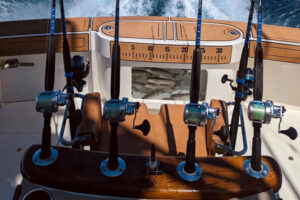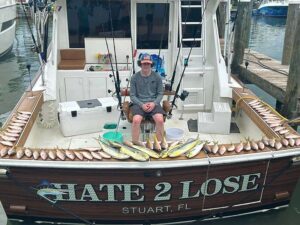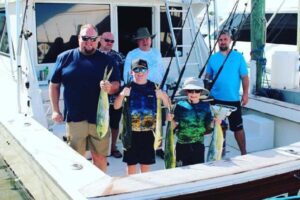Florida’s Treasure Coast, including the waters off Stuart, allows anglers to target the hard-fighting and delicious grouper. These bottom-dwelling fish are known for their strength and tenacity, making them a favorite among sportfishing enthusiasts. This blog post shares expert tips and techniques for catching grouper in Florida with Hate 2 Loose Fishing Charters in Stuart.
Groupers (family Serranidae) are found in rocky and coral reefs of the tropics and subtropics around the world (161 species), and are also subject to threats from over-exploitation from fishing, especially for the live fish trade, given their high commercial value.
There are many species of Grouper found all around the world and you could easily write a whole book about them. Out of the 161 species, Gag Grouper, Red Grouper, and Scamp Grouper are the most common groupers, with an occasional Black Grouper or Warsaw Grouper. One of the best things about Groupers is the many colors and variations. You could spend your whole fishing life chasing all the different kinds of Grouper worldwide, and it would not be a life wasted.
Goliath Grouper Fishing Charters in Stuart, FL
Goliath Grouper Fishing Charters in Stuart, FL has become a popular activity over recent years. These powerful fish are an amazing catch! The thrill of hooking these beasts and then battling them to the surface is like no other.
Like many species of fish, grouper are comfortable being opportunistic feeders and will eat a wide array of dead and live baits. Huge diameter mouths, packing an intense suction mechanism, allow groupers to eat just about anything smaller than them. Preferred live baits include greenies (threadfin herring), sardines, cigar minnows, grunts, and pinfish.
Understand the Grouper Season
While grouper can be caught year-round in Florida, the peak season for most species falls between April and September. Remember that some species, such as gag grouper, have specific harvest seasons and regulations. Always check the Florida Fish and Wildlife Conservation Commission’s website for the most up-to-date information on regulations and seasons.
Locate the Grouper
Grouper are typically found near underwater structures such as reefs, wrecks, and ledges where they can hide and ambush their prey. When targeting grouper, focus on areas with rocky or coral bottoms, as these provide ideal habitats for the fish.
Best Techniques to Catch Groupers
Groupers have large mouths relative to their body size and can engulf large baits. They often eat other reef fish hooked as they are being reeled in. If you are using a scaled-down tackle for the smaller reef fish, you will need a lot of luck to avoid making a tackle donation to the local reef foundation.
Grouper fish can weigh between 50 to 175 pounds, so fishers need to ensure they get the appropriate tackle. For example, they’ll need at least a 200-pound test line to ensure that the grouper doesn’t snap the line during a fight. The higher the poundage on the line, the heavier the fish a person can catch, so aim high when going for groupers.
Grouper Require Heavy Tackle
With a conventional grouper rig, the reel sits on top of the grouper rod so that most of the pressure is put on the rod. Then, the line is wound in the same direction that it goes out, offering the angler better leverage. And you’ll need all the leverage you can get to land a giant grouper.
Never forget that grouper are big fish that put up a fight. Once hooked, they love to run and are easy to lose. They head to ledges and holes, seeking to shake the hook or snap your line.
This means you’d better use heavy tackle. If plan to muscle a big fish, you’ll want to gear up with a stout rod and reel, and use an 80 to 100 pound mainline. Anything less, and you’ll risk losing whatever you hook.
When to Use Chum
Using chum is part of the seduction of catching grouper.
The experts use frozen squid or sardines as chum. As smaller fish chew it up and disperse their leftovers into the water, the larger grouper gets stirred up and ready to feed. Now, you’re ready to follow up the chum by dropping a live pinfish or grunt to attract the larger fish.
Chumming works especially well when anchored and bottom-fishing because the chum draws the grouper away from holes. Yet it’s not as successful when fishing close to a reef because they will go back into holes where they are more likely to break off.
Try Trolling
Many people have a lot of success trolling.
One reason is that that you can cover a lot of ground quickly, giving yourself a better chance of hooking a large grouper. Another is that the fish have to come out of the holes to take the bait.
Just don’t get in a hurry. Take it slow. You won’t want to move faster than two knots because you don’t want to outrun the fish. Give them a chance to catch up and take your bait.
What Kind of Bait to Use When Trolling
When trolling for grouper, you can use natural or artificial bait. Lures designed to dive to depths of 30 or 40 feet typically catch many fish.
These artificial deep-water baits work great when you’re trolling slowly over ledges and shallow reefs. But when you’re using natural bait, planars and downriggers are better tools for getting your bait as deep as possible.
What Type of Line to Use When Trolling
Anglers love to debate their gear. Everyone has their preferences and beliefs about what works best. That being said, if you’re going to fish for grouper, you’d better choose a line that can handle a big fish that will put up a fight.
Monofilament line is the best line for trolling for grouper because it is able to stretch. And because you’ll typically be trolling in depths of 60 feet or more, monofilament allows you to set the hook yet still stretch enough so that you don’t end up cutting the fish’s mouth when it strikes your moving bait.
Monofilament is strong yet forgiving, making it the perfect line for trolling.
What Type of Line to Use When Bottom Fishing
The great advantage of the braided line is sensitivity. A line that offers greater sensitivity is important when bottom fishing because you’ll work depths of around 160 feet. That’s a lot of lines, and you’ll need to be able to feel a strike when something hits your bait.
Remember that the braided line is thicker and more visible in the water. You’ll need to use a leader four to six feet long and clear so you don’t spook any fish. Leaders are typically made of either monofilament or fluorocarbon, and either material will work fine.
The Keys to Catching Grouper
Grouper is a great species of sport fish, and grouper fishing is a true thrill that anglers of any age can appreciate. But to succeed, you’ll need the right gear and to use the best bait for grouper.
Most anglers love a good challenge, and few other sport fish offer a bigger challenge. Whether you prefer fishing in the heat of summer or the winter chill, grouper provides an awesome time on the water!
What are the regulations for fishing Groupers in Florida?
Regarding recreational fishing, you can expect Florida to have one of the strictest rules. These rules are governed and implemented by the Florida Fish and Wildlife Conservation Commission. They aim to protect and manage fish and wildlife resources for their long-term well-being and the benefit of people. You can read the guidelines here.
Our captain at Hate 2 Lose Sport Fishing Charters has more than 30 years of experience fishing the Atlantic coast, the Florida Keys, and the Bahamas. He has extensive knowledge of catching Groupers. You just have to enjoy the Stuart, Florida Charter experience and cherish it.
Hate 2 Lose Sport Fishing Charters is located at Pirates Cove Resort and Marina Fishing Experience Charter.
Dock Area: Pirates Cove Resort and Marina 4307 SE Bayview St Stuart, Fl Slip N4
Call us now at 561-818-6856 or 231-670-9873 to book your Charter Boat Trips on Hate 2 Lose Fishing Charters today! Or book here for only $500!










